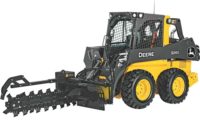Product Snapshot: Excavator and Trencher

The Deere 85G excavator has an operating weight of 19,564 lb, with a maximum digging depth of 14 ft, 10 in.

The Minnich dust-control system captures harmful silica dust during concrete drilling.

The ST37X stand-on trencher is designed for basic trenching applications, including creating footings and installing drainage pipe.

The LCL700 luffing-jib crane is available in two configurations, with maximum load capacities of 64 or 50 metric tons.




Small Excavator: Auxiliary Hydraulic Controls
The Deere 85G excavator has an operating weight of 19,564 lb, with a maximum digging depth of 14 ft, 10 in. It is powered by a 57-hp engine that meets Tier 4 Final emissions standards. The excavator can be equipped with a hydraulic coupler that allows it to use backhoe hydraulic attachments. Hand controls for the auxiliary hydraulic system are standard, granting the operator finer control over a wide range of attachments.
Deere Construction & Forestry Division; www.deere.com
Concrete Drill Rig: Dust Control
The Minnich dust-control system captures harmful silica dust during concrete drilling. The suction vacuum can be fitted to any Minnich dowel-pin drill rigs or similar models and features both automatic and manual purge controls. Proper use of the dust-control system brings the dowel-pin drill rigs into compliance with the Occupational Heath and Safety Administration’s silica-dust rule, which is set to go into effect in June 2017.
Minnich Manufacturing; www.minnich-mfg.com
Stand-on Trencher: Capable of Offset Trenching
The ST37X stand-on trencher is designed for basic trenching applications, including creating footings and installing drainage pipe. The trencher is powered by a 37-hp Yanmar diesel engine and is capable of digging trenches up to 16 in. wide and 36 in. deep. Further, it can dig along the centerline or offset, allowing it to trench alongside obstacles. The operator’s platform is spring-mounted to reduce vibration, with enough ground clearance to handle debris and uneven terrain.
Ditch Witch; www.ditchwitch.com
Luffing-jib Crane: Multiple Configurations
The LCL700 luffing-jib crane is available in two configurations, with maximum load capacities of 64 or 50 metric tons. Using simple, on-site modifications, each crane can be switched to single-line pull from double-line pull, resulting in lifting capacities of 32 and 25 metric tons, respectively. This modification also significantly increases hoist speeds, allowing the high-capacity crane to adapt to different lifting conditions. It has a maximum working radius of 65 meters, which can be reduced in 5-m increments to 30 m. The crane has a minimum working radius of only 4 m, allowing it to work on crowded sites.
Linden Comansa; www.lindencomansa.com
Manufacturers can send information on new products to ENR.products@enr.com.





